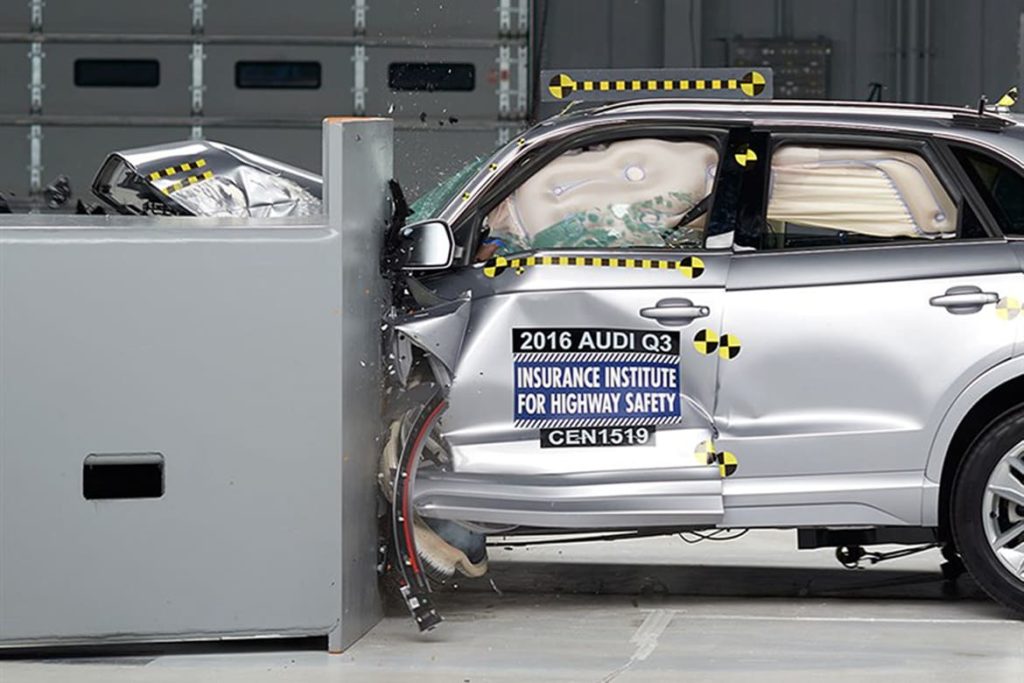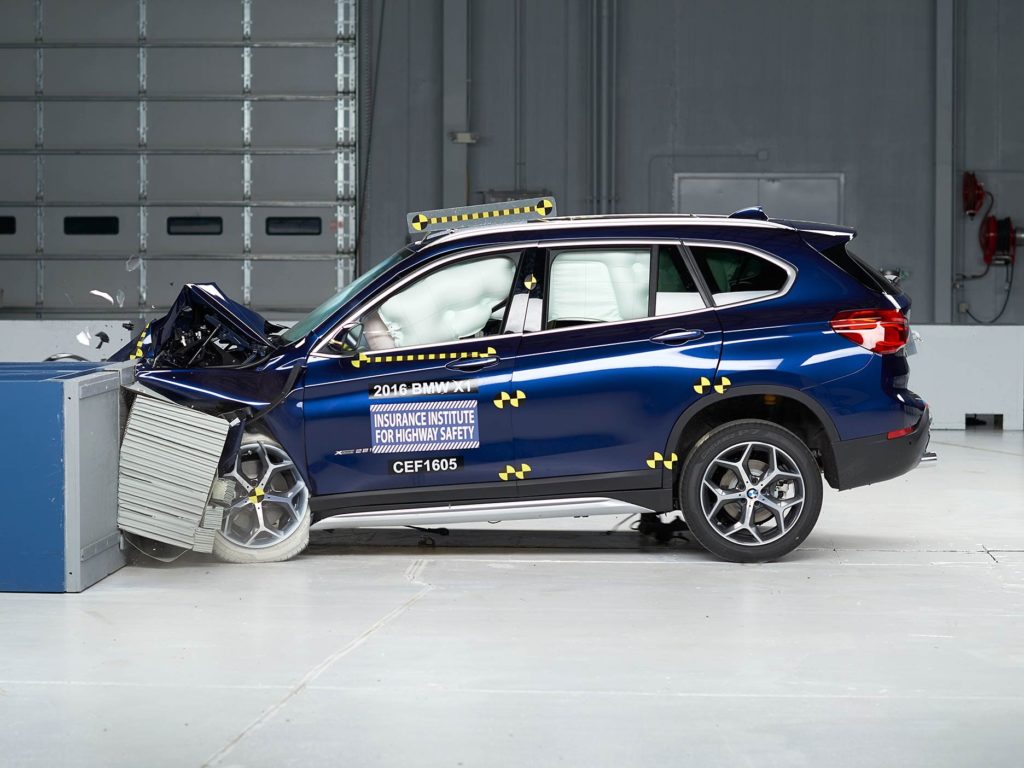2016 BMW X1 Vs 2016 Audi Q3 – CRASH TEST
The redesigned-for-2016 Audi Q3 has earned the Insurance Institute for Highway Safety’s Top Safety Pick rating. The luxury compact SUV received the highest-possible score of good in all areas of the institute’s crashworthiness testing.IIHS rates vehicles good, acceptable, marginal or poor based on their performance in five tests, including moderate front overlap, small overlap front, side, roof strength and head restraints. The new Q3 did not qualify for the institute’s highest honor, Top Safety Pick Plus, which requires that a vehicle earn an advanced or superior score for front crash prevention systems. The Q3 does not offer a front crash prevention system.
What is available, however, is a full complement of other safety features. These include front and rear side curtain airbags and front-seat-mounted torso airbags, a rollover sensor designed to deploy the side curtain airbags in the event of a rollover, electronic stability control, antilock brakes and programmable daytime running lights. Of the Q3’s performance in the stringent small overlap front test, which approximates what happens when the front corner of a vehicle crashes into, for example, a utility pole, IIHS said: “The dummy’s position in relation to the door frame, steering wheel, and instrument panel after the crash test indicates that the driver’s survival space was maintained well.”

2016 Audi Q3 Safety Features
Anti-lock brakes
ABS brakes automatically sense when a tire has stopped rotating under extreme braking, and will modulate the brake pressure to allow the tire to rotate. This increases the vehicles ability to turn while braking.
Stability control
Stability control automatically senses when the vehicles handling limits have been exceeded and reduces engine power and/or applies select brakes to help prevent the driver from losing control of the vehicle.
Front-impact airbags
Front-impact airbags for the driver and passenger have been designed to protect the head during a frontal crash.
Side impact airbags
Side impact airbags for the front seats have been designed to protect the torso during a side impact collision.
Overhead airbags
Overhead airbags are used to protect the occupant’s heads in the event of a side collision or rollover.
Pretensioners
Seatbelt pretensioners automatically tighten seatbelts to place the occupant in the optimal seating position during a collision.
Security system
The vehicle is equipped with a means of anticipating and/or detecting unwanted vehicle intrusion. The vehicle is equipped with an ignition disable device that will prevent the engine from starting if the correct original manufacturer key is not used.
2016 BMW X1
Perhaps more than any other model, the X1 exemplifies the shift going on at BMW. That the X1 is the first front-drive-based car to wear the BMW badge in the US is both remarkable and doesn’t matter at all. Some background: The first X1, sold here for the latter half of its six-year run, was an Old BMW. Based on E90 3 Series underpinnings, it was basically a tall, last-gen 3 wagon, a car on short stilts. We loved it. It drove almost exactly like a good 3 Series at a time when that 3 Series was no longer available. It sold in okay numbers. It’s gone now. This new X1, the 2016 model, is a sort of about face, or at least a right-hand turn in the engine compartment. This is New BMW. The base engine is again a 2.0-liter four-cylinder, a new design based on the company’s modular engine architecture that can spit out threes, fours, and sixes using the same component set. It’s mounted transversely, not longitudinally like in the rest of BMW’s US offerings. It loses some horsepower to the last X1’s 2.0 (228 hp versus 240) and a bit of torque (258 lb-ft down from 260). Again, few will notice. The optional 3.0-liter turbocharged six from the last generation is gone. Not many customers chose it, and the six likely wouldn’t fit under the hood of this rearranged X1. EPA fuel-economy numbers match those from the 2015 xDrive28i exactly – 22 mpg city, 32 highway – so no gains there. So packaging won. There’s really no other explanation for the longitudinal-transverse swap, except that maybe it’s less expensive to build this way. EPA fuel-economy numbers match those from the 2015 xDrive28i exactly – 22 mpg city, 32 highway – so no gains there. But the packaging advantages are abundant. The interior is somewhat narrow, but it’s opened up a bit by the lack of a transmission tunnel that would normally eat space between the front occupants. Instead, the center console is set low, with a tall shift lever rising practically from the floor up to meet your hand. There’s storage forward of the shifter and a folding center armrest that opens for small items. The original X1 was sold here with rear-wheel as well as all-wheel drive. For obvious reasons, that won’t be the case this time around. BMW also won’t sell a front-drive model here (although one is offered in Europe and elsewhere) likely because it would involve the admission that this is not your average BMW, but instead a New BMW, one designed for more people and fewer enthusiasts. The four-cylinder is smooth and delivers its power with few hints that it’s turbocharged. All of this from a company that still has a page on its consumer website dedicated to explaining the advantages of rear-wheel drive. The change was inevitable, but it might take some time to sink in. It’s made a little easier to bear when you remember that BMW makes Minis

2016 BMW X1 Safety Features
Anti-lock brakes
ABS brakes automatically sense when a tire has stopped rotating under extreme braking, and will modulate the brake pressure to allow the tire to rotate. This increases the vehicles ability to turn while braking.
Stability control
Stability control automatically senses when the vehicles handling limits have been exceeded and reduces engine power and/or applies select brakes to help prevent the driver from losing control of the vehicle.
Front-impact airbags
Front-impact airbags for the driver and passenger have been designed to protect the head during a frontal crash.
Side impact airbags
Side impact airbags for the front seats have been designed to protect the torso during a side impact collision.
Overhead airbags
Overhead airbags are used to protect the occupant’s heads in the event of a side collision or rollover.
Knee airbags
Knee airbags help to protect the occupants lower extremities from serious injury in the event of an accident.
Pretensioners
Seatbelt pretensioners automatically tighten seatbelts to place the occupant in the optimal seating position during a collision.
Security system
The vehicle is equipped with a means of anticipating and/or detecting unwanted vehicle intrusion. The vehicle is equipped with an ignition disable device that will prevent the engine from starting if the correct original manufacturer key is not used.
VIDEO
https://www.youtube.com/watch?v=BwM5S0PEUGI
Video by : CAR TV via youtube
Car information by : autoblog.com
